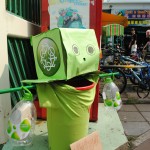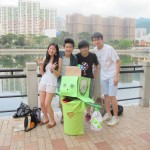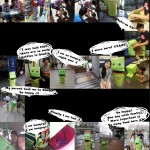Sha Tin: RE-CYCLING with the Hungry Kid
Authors. LEUNG Ka Ho Izaac, PANG Yiu Wai, TSUI Oi Yin Rose, YIU Chi Ngo Geo
Issues and Potentials: Transportation problems – imbalanced usage of the cycling lane during weekdays and weekends; 65 people/minute during weekends; five people/minute during weekdays.
Waste: High daily waste disposal in the district, as compared to the district’s population; Sha Tin’s daily municipal waste: 9.51% of the total in Hong Kong; Sha Tin’s population: 8.90% of the total in Hong Kong.
Ideas and Aims: The “fun theory” — making cycling and recycling a fun thing to do. Encourage the local community to utilise the existing resources (i.e. the cycling lane present in the district). Arouse people’s awareness towards the importance of recycling.
Proposal 1: Painting the cycling lane. Paint the cycling lane along the Shing Mun River with graffiti and other appealing drawings, invite students from the local primary and secondary schools to participate in the painting process. Encourage people to cycle instead of using fossil-fuel consuming vehicles. Arouse the local communities’ awareness about a low-carbon lifestyle by involving them in this project.
Proposal 2: The Hungry Kid: Create a recycling bin with a sensor which when it detects people will say I AM HUNGRY!; Place it at local bicycle renting shops (next to drink vending machines).
An amusing way to encourage people to recycle their plastic bottles/ aluminium cans after drinking. Especially effective at the bicycle renting shops where cyclers usually stop to take a rest and have a drink.
Feasibility and Results
Proposal 1: Painting the cycling Lane: Subjected to the issuance of Government’s license, the cycling lane is yet to be painted.
Proposal 2: The Hungry Kid: Our group placed the “Hungry Kid” at the bicycle renting shop at Sha Tin Central Park, next to a drink vending machine on a Saturday afternoon for one hour. 14 plastic bottles were collected, therefore a projection of 13440 bottles collected in a year and 18 trees can be saved, reducing carbon emissions. People observed, are amused by the physical appearance of the recycling bin and its ability to say “I AM HUNGRY” as they approach the bin.
Conclusions: Our project is one based on the “fun theory”— environmental protection need not be always inconvenient and dull, it can also be fun, amusing and a pleasurable act. With this project, we hope to allow the general public to experience a new way of realising a true low-carbon lifestyle while having a blast.



